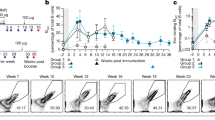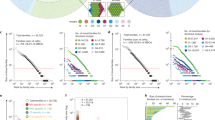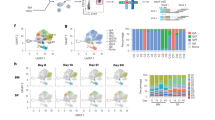Abstract
Antigen-specific B cells bifurcate into antibody-secreting cells (ASCs) and memory B cells (MBCs) after infection or vaccination. ASCs (plasmablasts) have been extensively studied in humans, but less is known about B cells that become activated but do not differentiate into plasmablasts. Here we have defined the phenotype and transcriptional program of a subset of antigen-specific B cells, which we have called 'activated B cells' (ABCs), that were distinct from ASCs and were committed to the MBC lineage. We detected ABCs in humans after infection with Ebola virus or influenza virus and also after vaccination. By simultaneously analyzing antigen-specific ASCs and ABCs in human blood after vaccination against influenza virus, we investigated the clonal overlap and extent of somatic hypermutation (SHM) in the ASC (effector) and ABC (memory) lineages. Longitudinal tracking of vaccination-induced hemagglutinin (HA)-specific clones revealed no overall increase in SHM over time, which suggested that repeated annual immunization might have limitations in enhancing the quality of influenza-virus-specific antibody.
This is a preview of subscription content, access via your institution
Access options
Subscribe to this journal
Receive 12 print issues and online access
$209.00 per year
only $17.42 per issue
Buy this article
- Purchase on Springer Link
- Instant access to full article PDF
Prices may be subject to local taxes which are calculated during checkout







Similar content being viewed by others
References
Tangye, S.G. & Tarlinton, D.M. Memory B cells: effectors of long-lived immune responses. Eur. J. Immunol. 39, 2065–2075 (2009).
McHeyzer-Williams, M., Okitsu, S., Wang, N. & McHeyzer-Williams, L. Molecular programming of B cell memory. Nat. Rev. Immunol. 12, 24–34 (2011).
Singh, H., Khan, A.A. & Dinner, A.R. Gene regulatory networks in the immune system. Trends Immunol. 35, 211–218 (2014).
Wrammert, J. et al. Broadly cross-reactive antibodies dominate the human B cell response against 2009 pandemic H1N1 influenza virus infection. J. Exp. Med. 208, 181–193 (2011).
Wrammert, J. et al. Rapid and massive virus-specific plasmablast responses during acute dengue virus infection in humans. J. Virol. 86, 2911–2918 (2012).
Wrammert, J. et al. Rapid cloning of high-affinity human monoclonal antibodies against influenza virus. Nature 453, 667–671 (2008).
Corti, D. et al. A neutralizing antibody selected from plasma cells that binds to group 1 and group 2 influenza A hemagglutinins. Science 333, 850–856 (2011).
Thomson, C.A. et al. Pandemic H1N1 influenza infection and vaccination in humans induces cross-protective antibodies that target the hemagglutinin stem. Front. Immunol. 3, 87 (2012).
Wilson, P.C. & Andrews, S.F. Tools to therapeutically harness the human antibody response. Nat. Rev. Immunol. 12, 709–719 (2012).
Pinna, D., Corti, D., Jarrossay, D., Sallusto, F. & Lanzavecchia, A. Clonal dissection of the human memory B-cell repertoire following infection and vaccination. Eur. J. Immunol. 39, 1260–1270 (2009).
Frölich, D. et al. Secondary immunization generates clonally related antigen-specific plasma cells and memory B cells. J. Immunol. 185, 3103–3110 (2010).
Medina, K.L. & Singh, H. Genetic networks that regulate B lymphopoiesis. Curr. Opin. Hematol. 12, 203–209 (2005).
Nutt, S.L., Heavey, B., Rolink, A.G. & Busslinger, M. Commitment to the B-lymphoid lineage depends on the transcription factor Pax5. Nature 401, 556–562 (1999).
Nutt, S.L. & Kee, B.L. The transcriptional regulation of B cell lineage commitment. Immunity 26, 715–725 (2007).
Xu, H. et al. Regulation of bifurcating B cell trajectories by mutual antagonism between transcription factors IRF4 and IRF8. Nat. Immunol. 16, 1274–1281 (2015).
Oshansky, C.M. et al. Mucosal immune responses predict clinical outcomes during influenza infection independently of age and viral load. Am. J. Respir. Crit. Care Med. 189, 449–462 (2014).
Li, G.-M. et al. Pandemic H1N1 influenza vaccine induces a recall response in humans that favors broadly cross-reactive memory B cells. Proc. Natl. Acad. Sci. USA 109, 9047–9052 (2012).
Lyon, G.M. et al. Clinical care of two patients with Ebola virus disease in the United States. N. Engl. J. Med. 371, 2402–2409 (2014).
McElroy, A.K. et al. Human Ebola virus infection results in substantial immune activation. Proc. Natl. Acad. Sci. USA 112, 4719–4724 (2015).
Li, S. et al. Molecular signatures of antibody responses derived from a systems biology study of five human vaccines. Nat. Immunol. 15, 195–204 (2014).
Subramanian, A. et al. Gene set enrichment analysis: a knowledge-based approach for interpreting genome-wide expression profiles. Proc. Natl. Acad. Sci. USA 102, 15545–15550 (2005).
Amanna, I.J., Carlson, N.E. & Slifka, M.K. Duration of humoral immunity to common viral and vaccine antigens. N. Engl. J. Med. 357, 1903–1915 (2007).
Crotty, S. et al. Cutting edge: long-term B cell memory in humans after smallpox vaccination. J. Immunol. 171, 4969–4973 (2003).
Purtha, W.E., Tedder, T.F., Johnson, S., Bhattacharya, D. & Diamond, M.S. Memory B cells, but not long-lived plasma cells, possess antigen specificities for viral escape mutants. J. Exp. Med. 208, 2599–2606 (2011).
Takemori, T., Kaji, T., Takahashi, Y., Shimoda, M. & Rajewsky, K. Generation of memory B cells inside and outside germinal centers. Eur. J. Immunol. 44, 1258–1264 (2014).
Odendahl, M. et al. Generation of migratory antigen-specific plasma blasts and mobilization of resident plasma cells in a secondary immune response. Blood 105, 1614–1621 (2005).
Suzuki, R. & Shimodaira, H. Pvclust: an R package for assessing the uncertainty in hierarchical clustering. Bioinformatics 22, 1540–1542 (2006).
Nakaya, H.I. et al. Systems biology of vaccination for seasonal influenza in humans. Nat. Immunol. 12, 786–795 (2011).
Saito, R. et al. A travel guide to Cytoscape plugins. Nat. Methods 9, 1069–1076 (2012).
Magoč, T. & Salzberg, S.L. FLASH: fast length adjustment of short reads to improve genome assemblies. Bioinformatics 27, 2957–2963 (2011).
Ye, J., Ma, N., Madden, T.L. & Ostell, J.M. IgBLAST: an immunoglobulin variable domain sequence analysis tool. Nucleic Acids Res. 41, W34–W40 (2013).
Krzywinski, M. et al. Circos: an information aesthetic for comparative genomics. Genome Res. 19, 1639–1645 (2009).
Acknowledgements
We thank R. Karaffa and S. Durham for technical assistance. Supported by the National Institute of Allergy and Infectious Diseases of the US National Institutes of Health (HHSN266200700006C, 1P01AI097092 and U19AI117891 to R.A.; T32AI074492 to A.E.; and U19AI09525801, UM1AI100663 and U01AI104342 to S.D.B.), Advanced Immunization Technologies (280873), the European Union (R.A.), the National Center for Advancing Translational Sciences (UL1TR000454 to A.K.M.) and The National Council for Scientific and Technological Development of Brazil (H.I.N.). The content is solely the responsibility of the authors and does not necessarily represent the official views of the National Institute of Allergy and Infectious Diseases or the National Institutes of Health or that of the Centers for Disease Control and Prevention.
Author information
Authors and Affiliations
Contributions
A.H.E., K.J.L.J., S.D.B. and R.A. designed the study, interpreted data and wrote the paper; A.H.E. performed most of the experiments; K.J.L.J. performed next-generation sequencing of the IGH repertoire and devised, undertook and interpreted repertoire-data analysis; H.T.K. and H.I.N. analyzed the microarray data; C.W.D. and A.K.M. helped in data analysis and interpretation; K.M.R. processed repertoire-sequence data; and C.M.O., R.E., S.T., G.M.L., C.F.S., A.K.M. and P.G.T. helped in collecting and processing the clinical samples.
Corresponding authors
Ethics declarations
Competing interests
The authors declare no competing financial interests.
Integrated supplementary information
Supplementary Figure 1 ABCs do not spontaneously secrete antibodies.
(a) Ex-vivo ELISPOT assay of day 7 ASCs plated on ELISPOT plates coated with either the 2013/14 TIV or anti-human IgG antibodies. The numbers on the bottom-left side of some of the wells represent the number of spots counted in that well. (b) ELISPOT assay where day 7 ABCs were cultured for five days (see Methods) and plated on ELISPOT plates coated as in (a). Shown are the spots when only feeder (CD19–) cells or feeder cells and ABCs were plated.
Supplementary Figure 2 Sorting B cell subsets 7 d after vaccination against influenza virus.
A FACS plot showing the gating strategy used to sort naïve B cells (grey), MBCs (green), ABCs (blue) and ASCs (red).
Supplementary Figure 3 HA-positive ABCs do not spontaneously secrete antibodies.
(a) Ex vivo ELISPOT assay of day 7 sorted HA-positive ASCs and HA-positive ABCs plated on ELISPOT plates coated with either the 2009 pandemic H1 HA or anti-human IgG antibodies. The numbers on the down-left side of some of the wells represent the number of spots counted in that well. (b) ELISPOT assay where day 7 HA-positive ABCs were cultured for five days (see Methods) and then washed and plated on ELISPOT plates coated as in (a).
Supplementary Figure 4 Sorting strategy for the BCR-repertoire analysis of ABC and ASC clonal lineages.
FACS plots (gated on isotype-switched B cells) showing the different B cell populations sorted at (a) day 7 and (b) day 14 after TIV vaccination (n = 3).
Supplementary Figure 5 Outlines of sorted cell populations for long-term analysis of the BCR repertoire.
(a) Outline of the 2013/14 season study where RNA was purified from total PBMCs at days 0, 28 and 90 after vaccination, and from total ABCs and ASCs at day 7 and from HA-positive ABCs at day 14 after vaccination (n = 3). (a) Outline of the 2014/15 season study where RNA was purified from memory B cells and total PBMCs at days 0, 28 and 90 after vaccination, and from HA-positive and total ABCs and total ASCs at day 7 and from HA-positive ABCs, total ABCs and memory B cells at day 14 after vaccination (n = 3).
Supplementary Figure 6 Clonal tracking of day-14 H1-positive ABC lineages in the 2013–2014 season study.
Percentage of day 14 HA-positive ABC clonal lineages identified among day 7 ABCs (green) or MBC (orange) populations at days 0, 28 and 90 after vaccination for donors 157, 162 and 163.
Supplementary Figure 7 Tracking of IGH SHM of the ABC clonal lineages by B cell repertoire sequencing.
(a) Longitudinal tracking of median of mean IGHV SHM frequencies of B cell clonal lineages that included HA-specific ABC members at day 14 post-vaccination with TIV during the 2013-14 season. Bars show the 95% confidence interval. (b) Each panel represents the mean IGHV SHM frequencies for individual clonal lineages from donors 157, 162, 163 and 8. The color of each point indicates the B cell subset, the point size corresponds to the number of reads and linear regression lines are shown in blue.
Supplementary information
Supplementary Text and Figures
Supplementary Figures 1–7 and Supplementary Table 2 (PDF 1580 kb)
Supplementary Table 1
192 genes that were differentially upregulated in the ABC subset (XLSX 46 kb)
Rights and permissions
About this article
Cite this article
Ellebedy, A., Jackson, K., Kissick, H. et al. Defining antigen-specific plasmablast and memory B cell subsets in human blood after viral infection or vaccination. Nat Immunol 17, 1226–1234 (2016). https://doi.org/10.1038/ni.3533
Received:
Accepted:
Published:
Issue Date:
DOI: https://doi.org/10.1038/ni.3533
This article is cited by
-
Human memory B cells show plasticity and adopt multiple fates upon recall response to SARS-CoV-2
Nature Immunology (2023)
-
Peripheral helper-T-cell-derived CXCL13 is a crucial pathogenic factor in idiopathic multicentric Castleman disease
Nature Communications (2023)
-
Single cell transcriptomics shows that malaria promotes unique regulatory responses across multiple immune cell subsets
Nature Communications (2023)
-
COVID-19 Adenoviral Vector Vaccination Elicits a Robust Memory B Cell Response with the Capacity to Recognize Omicron BA.2 and BA.5 Variants
Journal of Clinical Immunology (2023)
-
B lymphocytes in COVID-19: a tale of harmony and discordance
Archives of Virology (2023)



